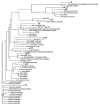Polyreactive monoclonal autoantibodies in multiple sclerosis: functional selection from phage display library and characterization by deep sequencing analysis
- PMID: 24455188
- PMCID: PMC3890994
Polyreactive monoclonal autoantibodies in multiple sclerosis: functional selection from phage display library and characterization by deep sequencing analysis
Abstract
Multiple Sclerosis (MS) is a chronic inflammatory demyelinating disease of the central nervous system that primarily affects young and middle-aged people. It is widely accepted that B lymphocyte activation is required for MS progression. Despite the fact that the exact triggering mechanisms of MS remain enigmatic, one may suggest that MS can be induced by viral or bacterial infection in combination with specific genetic and environmental factors. Using deep sequencing and functional selection methodologies we characterized clones of poly- and cross-reactive antibodies that are capable of simultaneous recognition of viral proteins and autoantigens. The latter, in turn, possibly may trigger MS progression through molecular mimicry. It was identified that two cross-reactive antigens are probably recognized by light or heavy chains individually. According to the high structural homology between selected autoantibodies and a number of various antiviral IgGs, we suggest that a wide range of pathogens, instead of a single virus, be regarded as possible triggers of MS.
Keywords: Multiple sclerosis; autoreactive B cells; cross-reactivity; deep sequencing; myelin basic protein; viral triggers.
Figures






Similar articles
-
Exposure to the Epstein-Barr Viral Antigen Latent Membrane Protein 1 Induces Myelin-Reactive Antibodies In Vivo.Front Immunol. 2017 Jul 6;8:777. doi: 10.3389/fimmu.2017.00777. eCollection 2017. Front Immunol. 2017. PMID: 28729867 Free PMC article.
-
Combinatorial antibody library from multiple sclerosis patients reveals antibodies that cross-react with myelin basic protein and EBV antigen.FASEB J. 2011 Dec;25(12):4211-21. doi: 10.1096/fj.11-190769. Epub 2011 Aug 22. FASEB J. 2011. PMID: 21859892
-
Heavy-light chain interrelations of MS-associated immunoglobulins probed by deep sequencing and rational variation.Mol Immunol. 2014 Dec;62(2):305-14. doi: 10.1016/j.molimm.2014.01.013. Epub 2014 Feb 16. Mol Immunol. 2014. PMID: 24534716
-
[Epitopes on myelin proteins recognized by autoantibodies present in multiple sclerosis patients].Postepy Hig Med Dosw (Online). 2004;58:472-82. Postepy Hig Med Dosw (Online). 2004. PMID: 15765008 Review. Polish.
-
Complex interaction between mutant HNRNPA1 and gE of varicella zoster virus in pathogenesis of multiple sclerosis.Autoimmunity. 2018 Jun;51(4):147-151. doi: 10.1080/08916934.2018.1482883. Epub 2018 Jul 11. Autoimmunity. 2018. PMID: 29996671 Review.
Cited by
-
Viruses and Multiple Sclerosis: From Mechanisms and Pathways to Translational Research Opportunities.Mol Neurobiol. 2017 Jul;54(5):3911-3923. doi: 10.1007/s12035-017-0530-6. Epub 2017 Apr 28. Mol Neurobiol. 2017. PMID: 28455696 Review.
-
The role of B cells in multiple sclerosis: Current and future therapies.Cell Immunol. 2019 May;339:10-23. doi: 10.1016/j.cellimm.2018.10.006. Epub 2018 Oct 21. Cell Immunol. 2019. PMID: 31130183 Free PMC article. Review.
-
Exposure to the Epstein-Barr Viral Antigen Latent Membrane Protein 1 Induces Myelin-Reactive Antibodies In Vivo.Front Immunol. 2017 Jul 6;8:777. doi: 10.3389/fimmu.2017.00777. eCollection 2017. Front Immunol. 2017. PMID: 28729867 Free PMC article.
References
-
- Hauser S.L., Oksenberg J.R.. Neuron. 2006;52(1):61–76. - PubMed
-
- Hemmer B., Nessler S., Zhou D., Kieseier B., Hartung H.P., Nat. Clin. Practice Neurol. 2006;2(4):201–211. - PubMed
-
- Compston A., Coles A.. Lancet. 2008;372(9648):1502–1517. - PubMed
-
- Jersild C., Fog T., Hansen G.S., Thomsen M., Svejgaard A., Dupont B.. Lancet. 1973;2(7840):1221–1225. - PubMed
LinkOut - more resources
Full Text Sources
